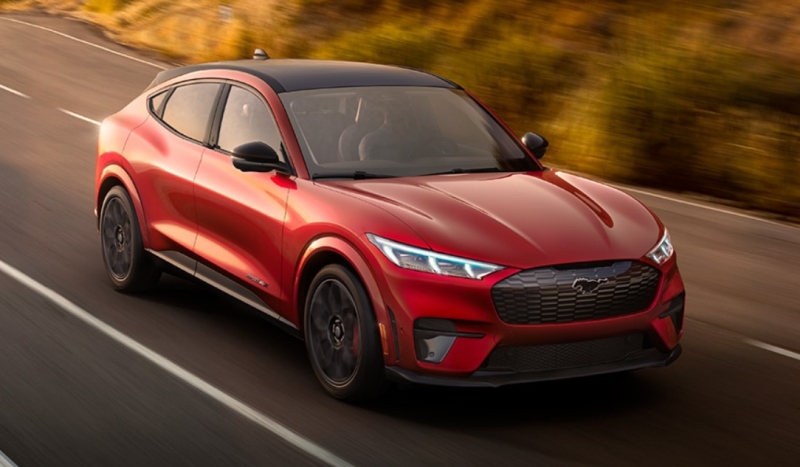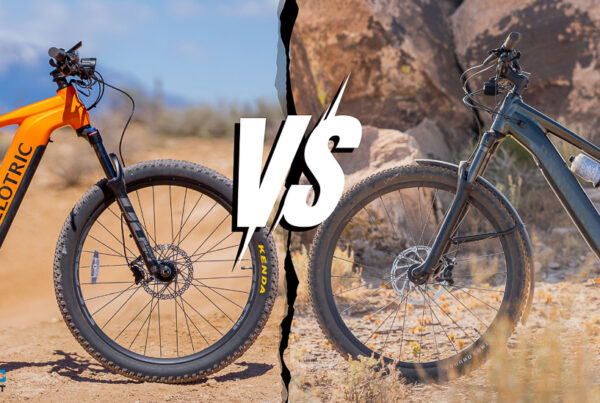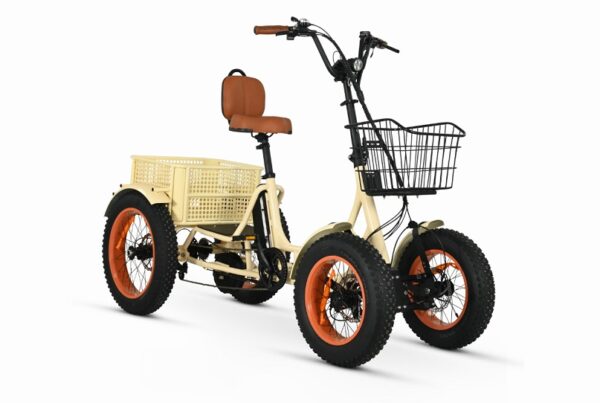There was a lot of buzz about GM doing this last year, but I read that the motor they were using was from the small “Bolt” EV, so it didn’t sound that interesting. Well now, I recently found out that their new kit allows builders to use this well-designed motor at 800V instead of the Bolt’s 400V, so that is a significant boost in power. Also, Ford recently announced that they are making a builders conversion kit with great specs, so…let’s take a look…
_____________________________________________________
Ford
First, I’d like to cover some of the electric vehicles that Ford and Chevy are using as it pertains to the electric motors they are using, so you will understand which vehicles to compare their kits to.
A lot of Ford fans got annoyed when Ford unveiled an electric SUV, and dared to use the venerated “Mustang” name on it. The Mustang Mach-E 4-door SUV is available in a RWD, AWD, and a higher-powered GT AWD model.
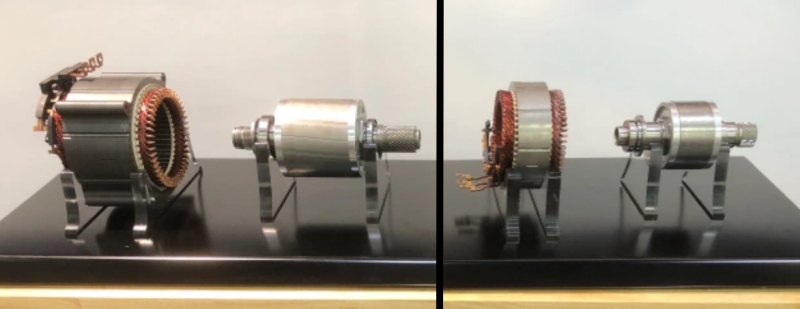
In the pic above, the motor on the left is the rear motor on the base-model Mach-E, with the smaller motor on the right driving the front of the AWD version. The Grand Tourismo / “GT” version of the Mach-E gets two of the larger motors shown on the left. If you order Fords “crate engine” (see below) you will get the motor on the left inside a mountable housing, with a current list price of $4100 (does not include controller or battery).
When mated to an appropriate controller, and fed approximately 400V, the Ford kit should return the performance of the stock base-model RWD Mustang Mach-E.
_____________________________________________________
The Ford “Mach-E 1400”
This is a PR halo build, only intended to polish the image of the Ford performance division. It is planned to be shown at road-race courses, and also at NASCAR in 2022.

It’s an impressive technological exercise, but I don’t anticipate them selling these to the public. The Mach-E 1400 uses seven YASA motors to provide AWD.
_____________________________________________________
YASA MOTORS
Yokeless And Segmented Armature / YASA
The Oxford YASA company is doing quite well. They designed a thin pancake motor that is stackable, so it is easily configurable to a variety of applications, rather than carrying a half-dozen sizes of motor. They were selected to be the power-plant for the Ford Mach-E 1400, which uses SEVEN of the YASA motors to provide at least 1400-HP.

This motor is liquid-cooled, and it’s a 3-phase axial-flux, with one central stator and two outboard permanent-magnet rotors.
The central shaft tunnel is longitudinal, and it’s pancake shape makes it compact when it’s driving a front wheel drive module. The Mach-E 1400 is AWD so it has another drive unit in the rear. The Mach-E 1400 splits up the seven YASA motors with four in the rear, and three in front.
Cars are not the only application for these. In 2021, Evolito also chose YASA motors to power a flying air-taxi that they are developing. They use them in 2-motor modules, which power two contra-rotating propellers on four spars, producing lift with eight motors, which provides significant redundancy. For a look at these, click here.
Yasa motors have also been used in other performance applications in the past, most notably the three YASA motor in the hybrid Koenigsegg Regera super-car. For a look at these, click here.
_____________________________________________________ _____________________________________________________
Ford Cobra Jet 1400
This package will never be sold to the public in a kit, but I found it interesting to add. It uses four in-line BorgWarner HVH250-115 motors mounted longitudinally (two are visible in the engine compartment), four inverters in the engine compartment, and a 3-speed automatic transmission coupled to a very conventional Ford 9-inch differential, which is quite popular in the drag-racing world.
These motor-inverter packages are being run at 800V and using up to 700 amps, with maximum output of 350-kW per motor, while spinning at up to 10,000-RPM’s. Ford collaborated with Cascadia Motion to create the CJ-1400’s RWD drivetrain. Ford is claiming1502-HP at the wheels from the car, and it achieved a best ET of 8.27 seconds at 168mph in the 1/4-mile. The car is rumored to weigh roughly 5000-lb.

NHRA Funny Car driver Bob Tasca III was behind the wheel of the CJ-1400 when it posted an 8.27 second 1/4 mile time…he is the grandson of famed Rhode Island Ford dealer Bob Tasca Sr; the very man responsible for the creation of the original Ford Mustang Cobra Jet. Back in 1967, Tasca was not impressed with the performance offered by the stock 390-ci Mustangs, so he offered customers a special-order 428-powered conversion.
“My grandfather invented the Cobra Jet back in 1968,” wrote Tasca III. The electric Cobra Jet accelerates like a slingshot. It pulls so hard I didn’t want to pull the ’chutes. I just wanted to keep going”
The Ford Mustang Cobra Jet 1400 drivetrain was designed and assembled by Cascadia Motion.
_____________________________________________________
Cascadia Motion
Global auto-parts supply conglomerate BorgWarner has progressively acquired a portfolio of electric powertrain businesses including Indiana’s Remy in 2015 for $950 million and the UK’s Sevcon in 2017 for $200 million. Then in 2019 they also acquired Reinhart Motion Systems along with AM Racing, both being based in Oregon.
BorgWarner formed Cascadia Motion LLC to acquire these assets and merge their complimentary operations under one corporate roof. Cascadia Motion is positioning itself to be a major player in EV and hybrid drive system development in the US.

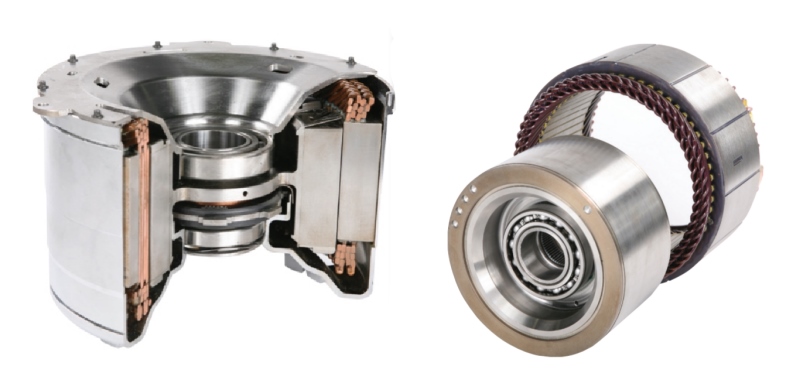
BorgWarner calls these motors the “High Voltage Hairpin” HVH series. The diameter of the rotor can be 250mm, 350mm, or 410mm for their large hybrid bus unit. They also can be had in various lengths, which is the 115mm number in the name.
The hairpin name refers to the long and thin “U” shape of the copper runs, which have a rectangular cross-section (instead of common round wire) to provide excellent “copper fill” in the available stator-coil air-space. After insertion into the stator, the loose ends are connected in a pattern to form the loops of copper. This method is used because it simplifies the rapid motor assembly by industrial robots.
This family of motors are specifically designed to work well with either a permanent-magnet rotor, or an AC induction rotor, depending on the application.
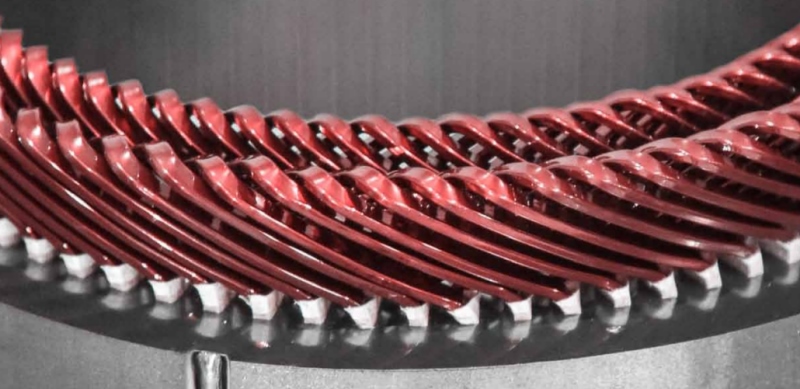


The 800V battery pack is made from four 200V modules in series from XALT Energy, a division of Freudenberg Sealing Technologies in Midland, Michigan.
“Part No. M-9000-MACH-E, the e-crate motor is now available at authorized Ford parts warehouse dealers or online at Ford Performance Parts. Retailing at $4,100, it is targeted for builders looking for a transverse-oriented powertrain to electrify a range of vehicles from modern to vintage cars, trucks and SUVs. Each Eluminator e-crate motor produces 281 horsepower and 317 lb-ft. of torque (when using 400V), and is street-legal in all 50 states.”
The motor spins at a maximum of 13,800 rpm and comes with a gear ratio of 9.05:1. It weighs 205 lbs (93 kg) and it’s roughly 370 mm (14.6 in) tall and 345 mm (13.6 in) wide. The assembly is 570 mm (22.4 in) long. The inverter and battery are not included.
Advanced Engine Management/AEM was acquired by Holley, a long-term partner with Ford, and AEM programmed a VCU-200 controller to work with the Eluminator package.
_____________________________________________________
General Motors
In the past, Chevy has provided special order options packages, to save dealers the trouble of needing to pick and choose from hundreds of options when talking to customers who wanted higher performance. The most famous is probably the 1967 “Z28” Camaro (raced by Penske-Sunoco), which was the homologation package that Chevy had to sell a certain minimum number of them to the public, in order to race it as a “stock” Camaro on the Trans-Am circuit.
Winning races often provided free advertising. But…prior to the Z28, for a variety of reasons, General Motors decided to stop all “official” factory support for NASCAR, Trans-Am, and drag racing in 1962.
However, there were still Chevy dealers who liked to race their product. A Pennsylvania dealer named Don Yenko used GM’s ” Central Office Production Order” system (COPO) to start ordering 1969 Camaros with options that made it a street-legal drag racer. The rare “ZL1” packaged Chevys are now worth quite a bit. I only mention these historical tidbits to explain where the “COPO” name came from, since GM chose to name their new electric PR mule an “eCOPO”
This past February 2021, McCue & Lane took the eCOPO electric Camaro to Pomona, California, for the 2019 NHRA Winternationals, and achieved a run of 9.83 sec

The eCOPO’s twin-motor module generates 760-HP and an impressive 651 lb-ft of torque. The battery pack consists of four modules that are located under the rear seats and in the trunk, which gives the eCOPO Camaro an approximate 56 percent rear-weight bias
Chevrolet has announced they will be providing an electric crate motor to the public, although it offers less power and torque than Fords kit. GM’s electric “Connect and Cruise” eCrate is sourced from the Chevrolet Bolt and makes 200-horsepower and 266 lb-ft (360 Nm), with a 60-kWh battery pack. That’s pretty snappy in a light Chevy Bolt, but with any larger heavier vehicle, you’ll need to connect this to a stock transmission, and…the good news is that the eCrate uses the mating interface of the modern popular “LS” family of engines and transmissions.
The kit comes with an inverter to power the drive-motor, a DC-to-DC converter to power the 12V-systems, as well wiring harnesses and pumps for the battery heating and cooling. The 800V battery pack for the Chevy eCOPO is made from four 200V modules in series from XALT Energy, just like the Ford above it.
To see a closeup of the Chevy Bolt motor internals in the video below, fast forward to the 49:00 mark to see the rotor, and then the stator is shown just after that.
To showcase their eCrate kit, GM converted a 1962 Chevy C-10 pickup truck to electric (the “E-10”), and also a 1977 K5 4WD Blazer.
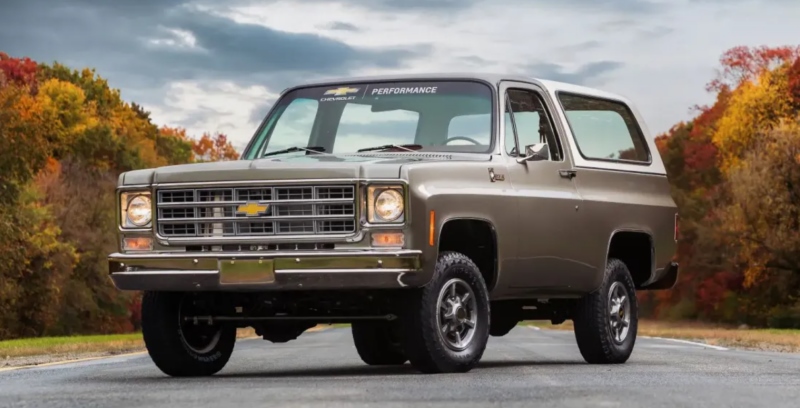
The new K5 Blazer-E retains as much of the stock Blazer as possible, and about 90% of the new parts installed for the eCrate package are factory components that are re-purposed from the Chevrolet Bolt
Energy for the eCrate kit is supplied by a stock 400V, 60-kWh Bolt battery pack. By using production controllers and wiring harnesses, it preserves many Bolt EV features, including electrical-shock protection, battery heating and cooling, battery-overcharge protection, and regenerative braking.
These motors will work at 800V, but GM will not supply a controller for that, so you’d be on your own…
_____________________________________________________
Electric GT
Southern California-based “Electric GT” has developed several sizes of conversion kit, and they are currently most famous for their EV conversions of V8 vintage cars. The pic below shows one of their smaller kits that they used to replace a 4-cylinder engine in a vintage Fiat 124 sports car.
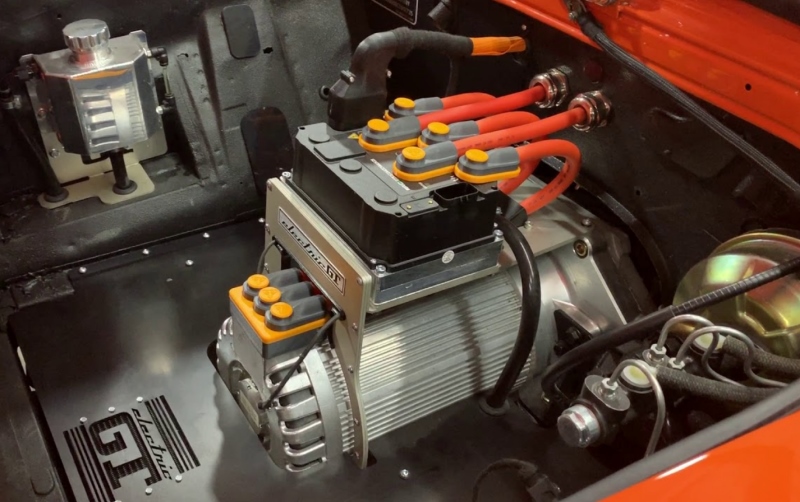
Their prices seem a bit high to me, but…they can sell you a kit to install yourself, or they can do a turn-key installation on your car. For more info click here.
_____________________________________________________
EV West
This company is located in San Marcos, just north of San Diego, California. They were one of the early adopters of EV conversions.

EV West has been doing conversions of many vintage cars using the rear-wheel-drive motor of a Tesla Model-S P85. It’s a liquid-cooled induction radial-flux inrunner, rated at 310 kW / 415-HP (they also have kits using various other motors). The stock configuration in a Tesla mounts the motor and inverter pack transversely, and this particular kit (that’s shown above) re-configures it with their custom adapters into a longitudinal mounting to allow an easy conversion to vintage RWD cars.
Tesla does not sell their motors and inverters to the public, so EV West harvests them from car wrecks. For a pic of the original traversely oriented configuration, click here.


For more information about using EV West for converting a car to electric, you can contact EV West by clicking here.
_____________________________________________________
Swindon Powertrain
The Swind company is in the UK, just west of London. They recently began providing an electric conversion kit for the Austin Mini, using their HPD-80 unit, and the name means “High Power Density, 80-kW” (107-HP). The drive unit looks like it could be easily adapted to quite a few small front wheel drive cars.
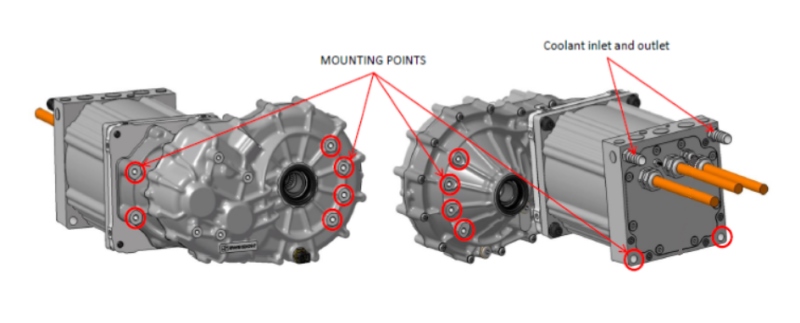

_____________________________________________________
Ford “Eluminator” kit
These “might” be available now, but you’ll have to keep checking to see. It’s part number M-9000-MACHE

The module uses the BorgWarner HVH250-115 motor in a self-contained module that has an integrated oil-pump, which uses a thin oil for immersion motor-cooling, and shedding the motors heat through the aluminum housing and also through two ports to connect to an external radiator (shown at the top/right of the pic above).
The Eluminator name comes from the “Stock Eliminator” class of drag racing. The cars in Stock Eliminator are limited to using 9-inch wide slicks, and various other restrictions as to what the owner can modify on a factory engine, while maintaining the car in a barely street-legal configuration.
_____________________________________________________
General Motors
The GM “Connect and Cruise” program is mostly modern gasoline engines and transmissions designed in kits that can be swapped into vintage vehicles. They do have a small one-page section dedicated to their “eCrate” which uses a single Bolt motor and controller.
That may not sound very powerful, but it is currently designed to mate to an existing transmission, so the road performance should be near stock for an average 6-cylinder. The most robust common automatic transmissions use 3-speeds, and due to the common interface, the builder can of course use a stock clutch and manual transmission with 3, 4 or 5 speeds.
The small Chevy Bolt is considered an “economy” EV, but it does have peppy acceleration at 400V with only one gear. Using a stock 3-speed transmission in a vintage car conversion should provide average V6 performance. For a comparison, the stunning performance of the eCOPO Camaro was achieved with two Bolt motors at 800V, so…
I haven’t found any pics yet of the GM eCrate, but when I do, I’ll post it here. It will likely look just like the Bolt motor module in the “Deep Dive” dis-assembly video shown a couple pages up. For more information on the eCrate, click here.
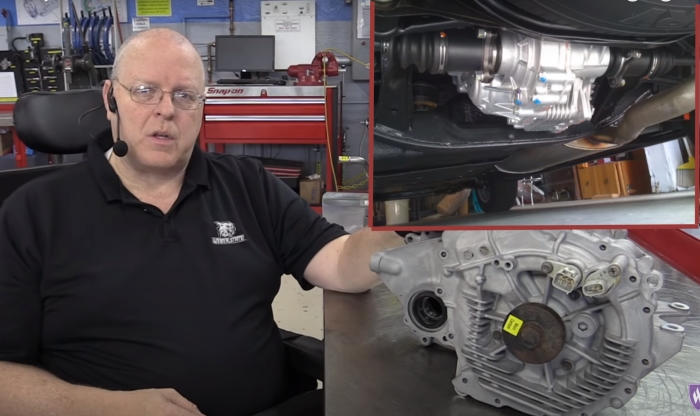
_____________________________________________________
My Conclusions
If you think the Ford and Chevy motor numbers in the article above seemed like they might be similar, go back and check again. You’re right, they are both the same BorgWarner HVH250-115 motor inside their respective housings. It might seem unusual for two such competitors to use the same components, but…your tax dollars were used to develop a great motor for everyone to use.
“… In May 2010, the U.S. Department of Energy finalized a $60.2 million American Recovery and Reinvestment Act grant for Indiana-based Remy to develop its HVH electric motor technology. This design can be used with either a permanent magnet rotor or AC-induction rotor…”
This was before Remy was bought by BorgWarner in 2015, so the research and patents are available to be used by a variety of American companies.
The Ford Cobra Jet 1400 was a hair faster than the Chevy eCOPO Camaro, but their times were very close in the quarter mile. They both used 800V batteries from Xalt, and they both used the same BorgWarner HVH250-115 motor that’s found in the Chevy Bolt…with the Chevy using two of them to keep its weight down, and the Ford using four of them for more torque.
EV West has a great conversion kit using the rear motor from the Tesla P85, but since they are salvaged from wrecks, you have to wait for a Tesla to crash before they can get their hands on one to convert for you.
The Ford and Chevy module housings are slightly different for their respective applications, and I think the Chevy kit will do quite well because it comes with an interface that matches the very popular LS V8 transmissions. The Ford kit can be used to make a FWD, RWD, or AWD car, but as a swap from a gasoline car, it would require a custom-cut and welded sub-frame. That’s not a deal-breaker, but it will limit builder enthusiasm…
I really do want to see a lot of vintage cars converted to electric, rather than have them melted down to recycle the steel. There are even a few antique steam-powered cars that are kept running by enthusiasts, but I doubt they are really driven very often. Most of my favorite cars are from the 1960’s, and it’s sad to see any of them crushed. It would make me very happy to see some of them converted to electric and driven every day, and these kits are going to be a good start in that direction…
_____________________________________________________
Written by Ron/spinningmagnets, January 2022
Source link

